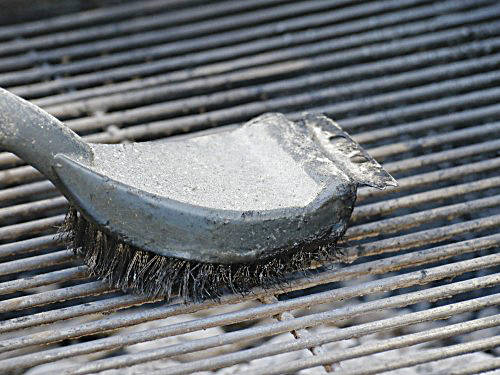
QUESTION: I clean my grill each time after I cook on it, using a steel wire grill brush to keep the grease and grime from building up on the grill racks. I’ve used the same brush for a couple of years now because I love how it cleans, but I’m wondering if I should get a new one this year.
That depends on just how old your grill brush is and what condition it’s in. If your grill brush is worn down, warped or has some missing bristles, you may want to consider throwing it out.
This is because you’ll want to be careful that you don’t inadvertently leave behind any wire bristles from the grill-cleaning brush that could end up in the meat or vegetables that you are grilling.
According to the Centers for Disease Control and Prevention, there have been several reported cases of internal injuries following unintentional ingestion of wire grill-cleaning brush bristles by both children and adults. The severity of the injuries have ranged from puncture of the soft tissues of the neck, causing severe pain on swallowing, to perforation of the gastrointestinal tract requiring emergency surgery, CDC said.
In fact, an estimated 1,698 consumers have gone to emergency rooms between 2002 and 2014 after having ingested wire bristles in grilled foods, according to a 2016 study in the journal Otolaryngology-Head and Neck Surgery.
The study authors said that while wire-bristle grill brush injuries aren’t common, they do tend to increase during the grilling season, which makes sense, of course. The months with the highest number of reported injuries are June, July and August, they said.
More detailed information on wire grill brush injuries can be found at saferproducts.gov, which allows consumers to list information on what their injuries were and how they occurred.
Consumer Reports last week offered these tips to help consumers avoid accidental ingestion of wire bristles when barbecuing:
Use a moist cloth or paper towel to clean the grill surface before cooking.
If you use a wire-bristle brush, thoroughly inspect the grill’s surface before cooking for the presence of bristles that might have dislodged from the grill brush and could embed in cooked food.
Depending on the type of grill you have, you may be able to clean it using a pumice stone or a coil-shaped bristle-free bush.
You may try using crumpled-up aluminum foil to brush loose food particles off a warm — but not hot! — grill rack or grate.
Another important grilling safety tip to remember is to always use a food thermometer to ensure that your meat is cooked to the correct internal temperature to destroy any harmful bacteria such as E. coli or salmonella that may be present, according to the U.S. Department of Agriculture.
For meats such as steak and pork, that temperature is 145 degrees Fahrenheit. For ground meats, including beef, pork, veal, and lamb, the correct temperature is 160 degrees, USDA says. And poultry such as chicken and turkey should be cooked to an internal temperature of 165 degrees.


